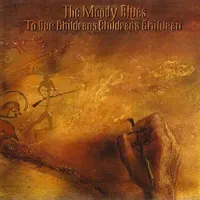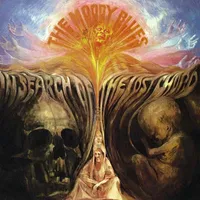"Genesis and Queen were in awe of the sounds we were making": The Moody Blues albums you should definitely listen to, and one to avoid
Originally just another R&B band, the Moody Blues would create one of the sounds of the late 60s/early 70s as psychedelic and progressive rock pioneers

Puzzlingly undervalued to this day, The Moody Blues deserve more credit as one of rock’s key innovators. From 1967-’72 the quintet released seven studio albums that pioneered a fusion of rock’n’roll, prog-pop and classical, creating richly symphonic pieces forged using a mix of ambition and technology.
“We broke down a lot of barriers and introduced people to new things,” founder member Ray Thomas told Classic Rock in 2013. “We had Genesis and Queen standing in the wings watching us, in awe of the sounds we were making.”
They were one of the first bands to use eight-track facilities and quadrophonic sound. It was a journey into the further reaches of experimentation owing much to the unbound scope of the Mellotron, which keyboard player Mike Pinder introduced to sometime touring partners The Beatles.
Commercially, the band struck gold. Over a career that spanned six decades, they sold in excess of 70 million records, enjoying scores of international hits and a concerted run of platinum albums. They were finally inducted into the Rock And Roll Hall Of Fame in 2018.
Formed in Birmingham in 1964, the Moodies signed to Decca as an R&B combo, and topped the UK chart with second single Go Now!. By ’67 they’d settled on the classic line-up of Thomas (flute, harmonica), Pinder (keyboards), Justin Hayward (guitar), John Lodge (bass) and Graeme Edge (drums, percussion). Everyone could write and sing, resulting in diverse creativity that fed directly into the wide panorama the music.
“Each one of us had a sustained level of ideas,” Pinder told us. “We were listening to everything, and everybody had a say. It felt like anything was possible.” Releasing seven albums in six years, along with a heavy tour schedule at home and in the US, inevitably took its weary toll.
The band went on hiatus in 1974, returning to action with 1978’s underwhelming Octave. But it was to prove the last hurrah with Pinder, whose departure soon afterwards signalled the end of the dream team.
With ex-Yes man Patrick Moraz as his replacement, they pressed on regardless, recording a series of hit-and-miss albums that grew more sporadic as years went by, but the passing of Ray Thomas in 2018 saw retirement confirmed, a decision reinforced when Edge and Pinder died in 2021 and 2024, respectively.
Justin Hayward and John Lodge remain active.

Days Of Future Passed (Deram, 1967)
Keen to showcase the band’s new ‘Deramic Sound’ technique, Decca encouraged the Moodies to go big on their second album. The group duly obliged, ditching R&B for a cohesive, day-in-the-life song suite that fused rock with orchestral elements, largely via the wonder of Pinder’s latest toy: the Mellotron.
The London Symphony Orchestra was a fictitious guise for a bunch of trusted session players brought in by arranger Peter Knight, and the music reached a symphonic pinnacle during new boy Justin Hayward’s outstanding Nights In White Satin. A masterful work that helped lay the foundations of prog rock.
To Our Children’s Children’s Children (Threshold, 1969)
Recorded during the summer of the first Moon landing, the Moodies’ fifth album embraced the age. They achieved lift-off immediately with Edge’s Higher And Higher (narrated by Pinder), complete with launch-pad effects and rocket-tipped guitar, while Watching And Waiting and the driving, dramatic Gypsy (Of A Strange And Distant Time) swiftly became fan favourites.
The culmination of the band’s adventures in symphonic sound, it still feels like the grandest of statements. Two years later, the Apollo 15 crew took the album with them into space.
In Search Of The Lost Chord (Deram, 1968)
A disarmingly trippy delight that had the band hoisting their freak flag into the warm psychedelic breeze of the times. LSD had entered the Moodies’ lives, bringing with it a sense of experimentation that sought to emulate The Beatles’ spiritual and creative enlightenment.
Cue songs about space, higher consciousness, philosophy, and the counterculture’s own antihero Timothy Leary as the subject of Thomas’s fittingly lysergic Legend Of A Mind. They’d expanded their creative palette too, with sitar, tabla and tambura adding exotic spice to Pinder’s Mellotron textures.
On The Threshold Of A Dream (Deram, 1969)
Having almost completely dispensed with psychedelia, the band offered a porous blend of rock and experimental music on their fourth album. Side one is a hard-driving mix of guitars and layered vocals as Hayward and Lodge attempted to outdo one another.
Pinder’s So Deep Within You, meanwhile, was soulful enough to warrant a cover by the Four Tops. Side two is altogether more out-there, exemplified by the mystical Camelot dream of Are You Sitting Comfortably? and Pinder’s strikingly grandiose three-part suite with The Voyage at its centre.
A Question Of Balance (Threshold, 1970)
Mindful of the problems of recreating To Our Children’s Children’s Children in a live setting, the band opted to strip things back on the follow-up. A Question Of Balance is as raw as the Moodies ever got, fired by a sense of urgency not heard since their earliest days.
Peace and love had been usurped by discord and paranoia by the 70s, a mood expertly captured by Question, Hayward’s response to the war in Vietnam. It’s the standout track, although Thomas also offered one of his best with And The Tide Rushes In, a conflicted ballad with fingerpicked guitar and princely effects.
Seventh Sojourn (Threshold, 1972)
The last of their seven golden-age albums, Seventh Sojourn expanded its reach with the addition of the Chamberlin (a precursor to the Mellotron). The songwriting was top-notch, from Hayward’s underrated New Horizons to the faraway longing of Thomas’s For My Lady.
But it was John Lodge who provided the two major hits, in the opulent form of Isn’t Life Strange and I’m Just A Singer (In A Rock And Roll Band), the latter a reaction to hard-core followers convinced of the Moodies’ messiah-like qualities. The band’s first chart-topping album in the States, it would also be their last studio record for six years.
The Magnificent Moodies (Decca, 1965)
The Moodies’ initial line-up lasted only for this debut album, with guitarist Denny Laine (later of Wings) and bassist Clint Warwick quitting in the aftermath. A curious collection of covers and originals, it’s very much slanted towards R&B, comprising versions of tunes by James Brown, Chris Kenner, Jeff Barry, Ellie Greenwich and George and Ira Gershwin.
Their raucous take on Willie Dixon and Sonny Boy Williamson’s Bye Bye Bird was an unexpected highlight, but the real keeper was Go Now!, previously a minor hit for Bessie Banks. With Laine excelling on lead vocals, the song topped the UK singles chart.
Every Good Boy Deserves Favour (Threshold, 1971)
Named after the EGBDF mnemonic for the treble clef, the group’s seventh album was something of a mixed bag. There was plenty of innovation and ambition here – not least on Procession, a full band composition that attempted to distil the entire history of music, featuring Moog, harpsichord and an early drum synth – but somehow it didn’t quite convince.
That said, it takes a hard heart to remain unmoved by Lodge’s lullaby for his baby daughter, Emily’s Song, and Pinder’s My Song is a piece of arresting drama. Best of all is The Story In Your Eyes, a bracing Hayward rocker.
Long Distance Voyager (Threshold, 1981)
The Moodies rode the transition to the 80s surprisingly well, surviving the departure of Pinder and taking their place among the new wave of electro-pop combos. And while acutely aware of their lack of hip cache (see the playful Veteran Cosmic Rocker), the band also brought a newfound sophistication to their songs.
Talking Out Of Turn is a richly orchestrated epic conceived by Lodge, while Hayward evoked their classic era with the sweeping The Voice, a major US hit to sit alongside the equally successful (but less persuasive) Gemini Dream. Status Quo producer Pip Williams is worthy of mention too.
And one to avoid...
You can trust Louder
The Moody Blues’s quality control tailed off sharply from the mid-80s (Christmas album December a surprising exception). And while there’s certainly little reason to commend either 1986’s The Other Side Of Life or 1991’s woeful Keys Of The Kingdom, the band’s real nadir was Sur La Mer.
Even Tony Visconti’s production couldn’t save it from a slow and painful death, mired as it is in faceless, synth-led pop/rock and drum machines. Chief songwriters Hayward and Lodge struggled manfully with substandard material that refused to buff up, while Thomas at least had the good sense to bow out of the sessions completely.
Sign up below to get the latest from Classic Rock, plus exclusive special offers, direct to your inbox!
Freelance writer for Classic Rock since 2008, and sister title Prog since its inception in 2009. Regular contributor to Uncut magazine for over 20 years. Other clients include Word magazine, Record Collector, The Guardian, Sunday Times, The Telegraph and When Saturday Comes. Alongside Marc Riley, co-presenter of long-running A-Z Of David Bowie podcast. Also appears twice a week on Riley’s BBC6 radio show, rifling through old copies of the NME and Melody Maker in the Parallel Universe slot. Designed Aston Villa’s kit during a previous life as a sportswear designer. Geezer Butler told him he loved the all-black away strip.











